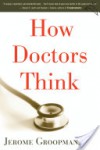


Groopman categorizes the kinds of errors in thinking that doctors can make (drawing on stereotypes, thinking too narrowly, clinging to an original diagnosis while ignoring later evidence), and he uses real cases as examples. While the clinical algorithms and practice guidelines that medical students are taught and that are promoted by hospital administrators and insurance companies are useful in many cases, he argues that they discourage doctors from thinking creatively when symptoms are vague and test results inconclusive. Oncologist and New Yorker staff writer Groopman ( The Anatomy of Hope, 2004, etc.) draws on conversations and interviews with other doctors, research in the field and his own experiences as both doctor and patient to unravel the question of how doctors reach a diagnosis and decide on a treatment. A revealing, often disturbing look at what goes on in doctors’ minds when treating patients, plus some advice to patients on how to work with their doctors to improve that process.


 0 kommentar(er)
0 kommentar(er)
